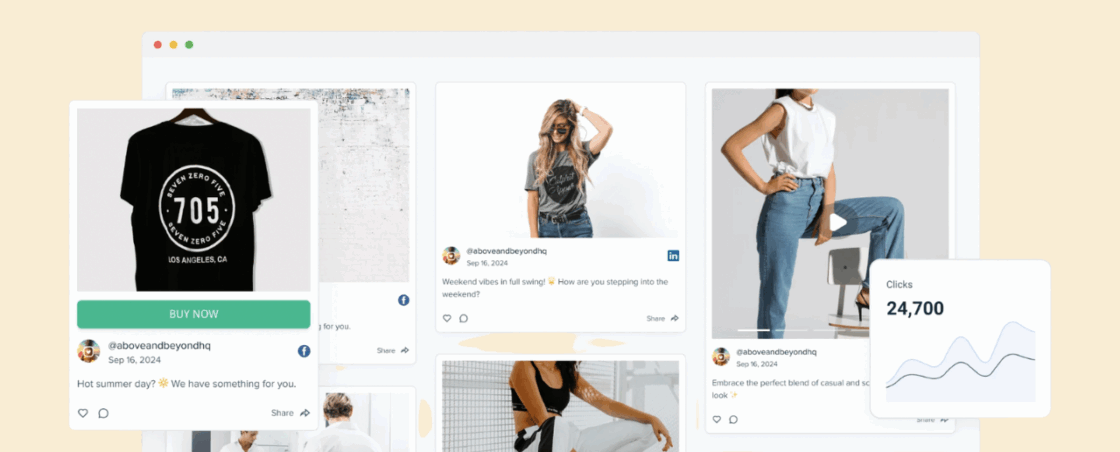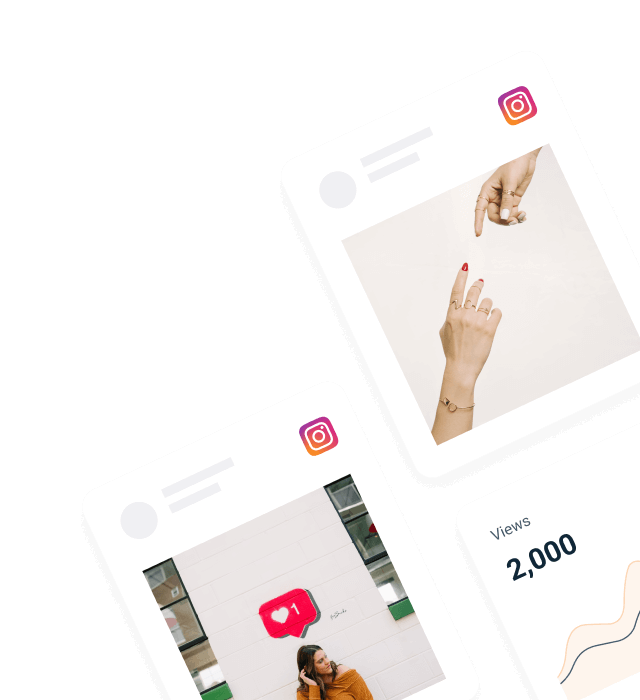What Is Social Retail?
What is social retail? Social retail is about reaching your customers where they already are—on social media sites and apps. It’s not necessarily about advertising products. It’s about creating actual relationships, getting conversations started, and making buying easy, whether online or in-store. Unlike traditional retail, today’s model lives and breathes on social networks, user-generated content (UGC), and the type of buzz that naturally happens through recommendations and shared experiences. The objective? Make the shopping experience feel seamless, personal, and shareable across both physical and digital channels.
Why Social Retail Matters in 2025
Social retail has moved from being “nice to have” to a necessity. According to Sprout Social, nearly 75% of consumers now check social media prior to making a purchase. And the trend is only increasing: social commerce globally will hit $1.2 trillion by 2025 (eMarketer).
When companies use social retail strategies and incorporate social media as an integral component of their strategy, they are able to:
- Build real, personal connections with customers
- Turn social media followers into buyers with in-app shopping tools
- Showcase authentic positive reviews and user-generated content
- Blend online and offline touchpoints into a single, cohesive brand experience across physical and digital channels
- Use analytics and customer data to stay agile and keep improving
What Is the Retail Environment?
The retail environment is every space—digital or physical—where someone interacts with your brand and makes a buying decision. That could be your website, store, Instagram profile, pop-up booth, or even product packaging on a Reel. Social retail nowadays connects these physical and digital channels into an integrated customer journey.
In social retail, these aren’t separate touchpoints. They’re a single ecosystem. A smart retail environment eliminates gaps—merging layout, digital footprint, customer service, and social media into one frictionless experience. For example, a boutique might create a selfie wall to encourage Instagram sharing, while simultaneously live-streaming real customer testimonials on their homepage. The goal is simple: create a brand experience that’s unified, easy, and engaging—no matter where or how one shops, in an online store or a physical store.
Key Elements of Social Retail
1. Social Media Channels
Each platform plays a different role:
- Instagram is perfect for shoppable visuals and e-commerce sales.
- Facebook works well for community building and live shopping events.
- TikTok delivers reach through trends and challenges on social media apps.
- Pinterest inspires future purchases and helps increase brand awareness.
- Twitter keeps things conversational and timely.
It’s not about being everywhere—it’s about showing up the right way, in the right place, for your audience on the most relevant social platforms.
2. User-Generated Content (UGC) & Word of Mouth
People trust what other people say. User-generated content—videos, images, positive reviews—creates credibility fast. Engage the customers. That may be through a branded hashtag campaign, a customer spotlight, or a giveaway.
Example: A skincare brand could launch a #GlowUpChallenge where customers post their results, and winners are featured across social media platforms.
3. Social Shopping & Effortless Paths to Purchase
Shoppers want fewer clicks and more convenience. Social commerce features like shoppable posts, product tagging, and in-app checkout help reduce friction and boost sales.
A furniture store could let people browse Instagram and buy instantly, then choose in-store pickup. It’s all about making the next step easy, whether in an online store or a physical location.
4. Community and Connection
Sales matter—but so does belonging. Brands that build an engaged community see stronger loyalty and more engagement.
Try loyalty programs, live Q&As, or simply replying to DMs. Look at Sephora’s Beauty Insider Community: they combine rewards, forums, and exclusive content to keep their audience close and engage customers.
5. Data and Analytics
Guesswork doesn’t scale. Use several online tools like Google Analytics, Facebook Insights, or Juicer to see what’s driving results. Leverage customer data to refine your effective social retail strategy.
If UGC consistently outperforms branded content, shift your focus. Your data tells you what your audience values—listen to it and utilize social retail tactics to optimize.
Building a Social Retail Strategy That Works
1. Set Clear Goals and Know Your Audience
What are you aiming for—more e-commerce sales, better engagement, more UGC? Build out customer personas: where do they hang out? What do they care about? What content moves them to action?
A home décor brand, for instance, might zero in on millennial homeowners who browse Pinterest for ideas and buy through Instagram or other social media platforms.
2. Audit Your Retail Touchpoints
Look at everything from mobile UX to your store layout.
- Are your product pages mobile-friendly for e-commerce?
- Are people posting about your brand—and are you reposting it?
- Could you add QR codes in-store to drive online activity and increase brand awareness?
Every detail matters. Align them all toward a shared goal and a seamless customer experience.
3. Plan Your Content and Engagement
Offer variety. Mix product reveals, tutorials, live sessions, customer stories, and behind-the-scenes moments. Each platform has its strengths—use them to engage customers and attract new customers.
Example: A fashion brand might host weekly Instagram Lives where stylists give real-time outfit advice and invite viewers to join the conversation on social media platforms.
4. Launch Social Shopping Features
Start with shoppable posts on Instagram and Facebook. Try video carousels, Story tags, or even pinned TikToks to test what works for your e-commerce sales.
A beauty brand could introduce a new product with an Instagram Story that includes a direct purchase link—simple and effective for boosting online sales.
5. Encourage UGC
Run campaigns that encourage customers to share their experiences. Keep it simple—and fulfilling—to take part in your brand ambassador scheme or UGC competitions.
A coffee store could host a #MyMorningBrew challenge, spotlighting a customer every week on their socials and in-store promotional materials, assisting with brand awareness and gaining new customers.
6. Collaborate with Influencers and Advocates
You don’t always need big influencers. Micro-influencers, brand ambassadors, and loyal customers will give you more authentic engagement. Give them a little guidance, but let their voice shine through.
Example: A sportswear brand might send complimentary samples to their most engaged community members, asking them to provide candid reviews and join a brand ambassador program.
7. Monitor and Adjust
Track your performance metrics. Double down on what’s working. If TikTok is driving more traffic than Facebook, redirect your time and budget there. Be agile and open to change, using online tools and customer data to refine your approach.
Best Practices for Social Retail
- Be authentic: People connect with brands that feel human.
- Respond: Comment back, thank customers, answer questions—it matters for an engaged community.
- Switch it up: Don’t only post products. Interpose tips, stories, and behind-the-scenes.
- Track results: Use analytics to understand what’s driving engagement and revenue.
- Keep up to date: Social media evolves quickly. Continue testing and be interested in emerging social retail strategies.
How Juicer Helps Social Retail
With Juicer, you can:
- Pull in content from Instagram, Facebook, TikTok, Pinterest, and more social media channels
- Filter and moderate posts to keep things on-brand
- Embed live social feeds on your website or online store displays
- Pull social proof from various platforms using hashtags
- Track engagement and adjust based on performance using several online tools
It’s a powerful way to unify your social presence, keep things organized, and turn real customer content into sales for your e-commerce business.

Final Takeaways
- Social retail connects social media with the full buying journey across physical and digital channels.
- It’s about community, connection, and seamless shopping experiences that engage customers.
- UGC, positive reviews, and authentic engagement build long-term trust and increase brand awareness.
- The right tools—like Juicer—can simplify execution and amplify results for your e-commerce and online store.
FAQs: Quick Answers on Social Retail
How do you make money with social retail? By selling directly on platforms, encouraging UGC, and creating a community that promotes your brand organically. Social retail tactics help boost sales and attract new customers.
What’s a social retail strategy? It’s a plan that combines social media, influencer content, customer engagement, and analytics to boost sales and brand loyalty. An effective social retail plan uses both physical and digital channels.
What are the main benefits? More sales, deeper customer relationships, greater reach, and a consistent brand experience across channels. You’ll also increase brand awareness and attract new customers.
How do I get started? Set goals, choose social media platforms, create content, encourage customer participation, and use tools like Juicer to stay organized and grow your e-commerce business.




